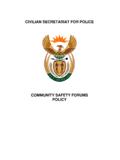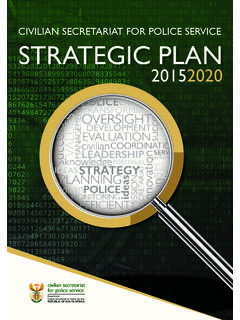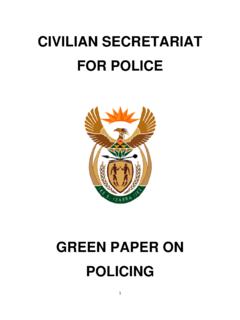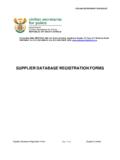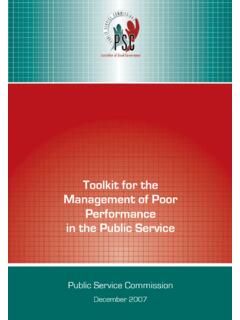Transcription of POLICY AND GUIDELINES: POLICING OF PUBLIC PROTESTS ...
1 1 MINISTRY OF POLICE POLICY AND GUIDELINES: POLICING OF PUBLIC PROTESTS , GATHERINGS AND MAJOR EVENTS 2 POLICY DOCUMENT ON THE POLICING OF PUBLIC PROTEST (RIOTS) AND MAJOR EVENTS 1. Introduction The dynamics in the POLICING of PUBLIC PROTESTS in South Africa after 1994 have undergone a major shift. Prior to 1994, the police, supported by the military, were tasked to suppress and use force to control unrests flowing from political opposition. The early 1990s experience increased political activities that resulted in key control challenges for riot control within the police force. Political marches and rallies that characterized the early 1990s could not be managed with the same repressive style as was the case prior to democratic negotiations.
2 POLICING measures against PUBLIC protest was generally characterized by arbitrary riot control and abusive actions of the Internal Stability Division (ISD) which brought controversy into PUBLIC order POLICING . Given several incidences of police clashes with protesters (Sebokeng, 1990 & Daveyton, 1991), the ANC led government after 1994 noted that the South African Police required transformation from the repressive style of POLICING to a police service for the people. This brought a challenge of introducing a POLICY framework in the approach to POLICING of PUBLIC PROTESTS and riots and clear guidelines for the use of force by SAPS. The Bill of Rights in the Constitution provides that everyone has the right, peacefully and unarmed, to assemble, to demonstrate, to picket and to present petitions.
3 Equally, so, the South African Police Act 68 of 1995 attempted to bring about a change in our POLICING approach with the introduction of community based POLICING and the need to expunge the apartheid POLICING style and stigma. Due to a lack of clear POLICY and guidelines, the SAPS reacted with operational POLICY based on lessons learned from a number of notable incidences involving the police and the PUBLIC . Transformation in the SAPS required the rationalization of PUBLIC order POLICING units, but has also exposed a serious gap within the POLICY environment. Post 1994, the SAPS 3 have faced another type of PUBLIC unrests and PROTESTS , only this time it has centered on PUBLIC service delivery, predominantly in the local More recently, the country has experienced a growing number of protest action and unrest which, in some instances are accompanied by serious provocation, intimidation, PUBLIC violence and even elements of criminality.
4 The main challenge for the SAPS is to respond to these manifestations within the spirit and context of a community orientated POLICING model and the Bill of Rights. This requires a realistic balance between acknowledging the rights of citizens to demonstrate versus the police s need to ensure peace and stability. These challenges require us to assess the effectiveness of PUBLIC order POLICING , especially with regard to its practice and response. Post 1994 PUBLIC order POLICING was located at SAPS area offices as part of Area Crime Combating Units. Unfortunately, during the subsequent restructuring of the SAPS, the Area offices were closed down and ACCUs significantly downsized. In view of recent increase in PUBLIC PROTESTS and gatherings it is important to determine whether PUBLIC order POLICING conforms with the constitutional and legal imperatives and whether the operational policies and strategies of the SAPS allows for appropriate planning, interventions and/or responses in respect of PUBLIC gatherings to deal with current and future challenges brought about in the process of POLICING PUBLIC PROTESTS .
5 2. SCOPE AND OBJECTIVES The POLICY aims to provide a framework with guidelines for the SAPS in reviewing and aligning its operational strategies and instructions applicable on POLICING of PUBLIC protest and related major events with a view of minimizing provocation, intimidation and violence. The objective(s) is to promote ideal crowd control and management capacity within the police in order to secure PUBLIC trust and maintenance of safety during PUBLIC gatherings; 4 provide a framework and facilitate the development of appropriate guidelines by the SAPS on the use of force in relation to crowd control and management that adheres to international accepted standards; establish the principle of intervention in controlling PUBLIC protest in order to proportionate the means of force that can be applied by the police.
6 Facilitate the introduction of appropriate training initiatives which must, amongst others, address the principle of first responder , guide SAPS operational planning and response, resource deployment and physical execution. 3. METHODOLOGY In drafting this POLICY , several approaches were combined to ensure maximum collation of information and verification of facts. Desktop research and literature review of case studies and international and regional country perspectives on the use of force; Interviews with relevant stakeholders (Academics, Researchers and SAPS with special focus on the subject; Research conducted on the POLICING of PUBLIC PROTESTS (by ISS Omar; Minnaar; Mistry) used case studies, specifically focusing on the Gauteng Provincial dynamics.)
7 Some researchers engaged, were able to relate to specific areas relevant to this POLICY where they were either exposed to or provided the opportunity to observe and evaluate. In terms of verifying the current status of POP in South Africa, a physical scrutiny of all relevant legislation and operational policies (National Instructions, Standing Orders, SAPS strategic plans, etc.) has been conducted and analysed. 5 4. POLICY STATEMENT One of the key areas is to consider whether the POLICING of PUBLIC PROTESTS in its current occurrence are consistent with the fact that police operations have to be undertaken within the context of people s right to protest. This does not diminish the threat to PUBLIC order which some PUBLIC protest may bring about. This can go beyond law and order which if the current POLICING of PUBLIC events is to go by is often applied loosely on any day that the police are confronted with protesters.
8 In developing POLICY and guidelines for the POLICING of PUBLIC PROTESTS and gathering, we need to ensure our POLICING approach is consistent with:- o Constitutionally accorded rights for all individuals o Effective and peaceful crowd control demands o An approach that does not impact negatively and enhances tensions between the police and community at the time of protest, this has potential to continue even beyond the protest o Our POLICING approach not generating the very violence it seeks to control in PUBLIC PROTESTS The POLICY aims to outline the standards and POLICY guidelines for SAPS to ensure proper handling of gatherings and conduct by police officers in protest situation. 5. LEGISLATIVE AND POLICY FRAMEWORK The Constitution of Republic of South Africa Since 1996, unresolved social issues have resulted in some members of the PUBLIC to expressing themselves through structured and non-structured PUBLIC gatherings, marches and sometimes PUBLIC PROTESTS .
9 However even where the underlying causes of PUBLIC protest actions are meritorious, the government has a residual effect to maintain 6 PUBLIC order. In addition there are some instances where organizers responsibilities are abdicated which led to criminality and criminal elements who have been able to make use of PUBLIC gatherings and PROTESTS to serve their own narrow objectives and purposes. The Constitution of the Republic of South Africa (Section 205 sub-section (3)) clearly defines the functions of the police to include: to prevent, combat and investigate crime, to maintain PUBLIC order, to protect and secure the inhabitants of the Republic and their property, and to uphold and enforce the law. In respect of the vested rights granted by the Constitution, of note is that not all PUBLIC protest can proceed unrestricted because the merits of PUBLIC protest actions are not always clear-cut.
10 Thus South Africa has also developed domestic laws, policies and regulation(s) within the framework of international laws on the right to PUBLIC gatherings including human rights standards. The challenges of effective implementation, monitoring and evaluation of these during PUBLIC protest however remain. Although the current legal framework makes provision for some negotiation and application procedures to hold a PUBLIC protest, gathering or march, it happens frequently that some of these PUBLIC PROTESTS starts spontaneously. The latter raises serious challenges since the SAPS are not afforded the opportunity to plan in advance and thus have to respond in a reactive manner. The Regulation of Gatherings Act 205 of 1993 The Regulation of Gatherings Act was enacted to regulate the holding of PUBLIC gatherings and demonstrations at certain places.
